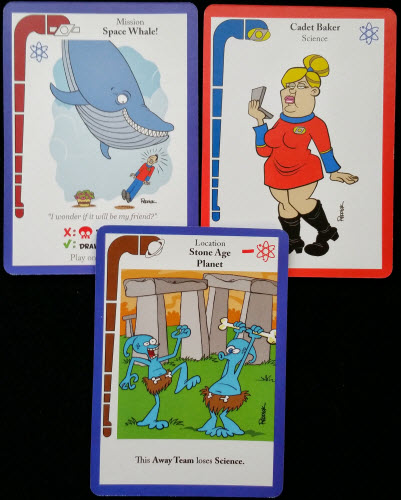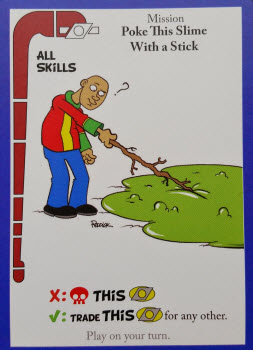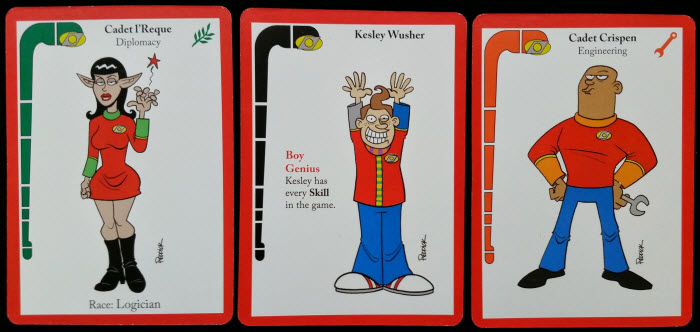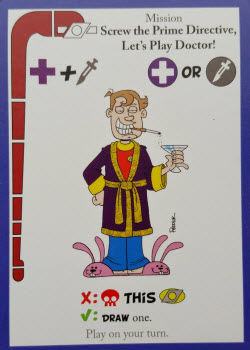Note: This review pertains to the Deluxe (Second) Edition of Redshirts
I’m not even supposed to be here! I’m just ‘Crewman Number Six’. I’m expendable. I’m the guy in the episode who dies to prove how serious the situation is. I’ve gotta get outta here…
-Guy Fleegman, as Unnamed Disposable Security Officer
The Premise
There’s an old sci-fi saying that goes something along the lines of, “When the going gets tough, the tough make sure they take a nameless low-ranking crew member with them.” In this case, though, the tough have skipped out on the mission altogether and are just sending in the cannon fodder. In Redshirts, players are starship captains competing to see who can rid themselves of their most inept, inexperienced, and unprepared crew members first by sending them out on deadly missions for which they are (obviously) not prepared.
The Rules
Redshirts is a conflict-driven card game that wants players to get to the crew-killing right away; it is playable right out of the box. The game consists of a mere two decks: the eponymous Redshirts themselves, and an assortment of Equipment, Location, Event, and Mission cards, known collectively as the Commander’s Log. To begin, each player is given four Redshirts laid out in front of them (known as their Away Team), and a hand of five cards from the Commander’s Log.
Just like graduation at the Academy, the starting player is whoever has the cadet with the last name first alphabetically.
Games are played over a number of short turns. Each player’s turn begins by refreshing any used Redshirts and ends by drawing back up to five cards. In between, they are free to play as many cards as they wish. Equipment cards are played on any Redshirt on the board. Locations work similarly and are played on a player’s Away Team, replacing any existing Location card. Events are one-shot cards that provide various challenges or special effects. Most of these three card types either add or remove some of the game’s six different Skills to the player’s Redshirt, and these Skills determine a Redshirt’s fate when sent on Missions.
Missions are the central challenge of the game – the main way in which a player gets their Redshirts killed. Missions may be played on any player who does not currently already have one, and each player must attempt to resolve a Mission on their turn.
In order to do so, the player selects a Redshirt from their Away Team and taps – sorry, Zaps – them. Every Mission states which Skills are necessary to succeed, and some Missions have also prerequisite Skill requirements to even attempt. Should none of a player’s Redshirts be capable for the Mission, it is discarded. However, as a penalty, that player must add a new Redshirt to their crew.

This Redshirt was destined to fail his science mission, until another player provided him with the right Equipment.
Otherwise, the Mission proceeds. Once the player begins the Mission, all players in turn order can attempt to modify the challenge by playing a card and / or using one of their own Redshirt’s special abilities (by Zapping them).
After all players have a chance at throwing a wrench in the works, the outcome of the Mission is determined. If a Redshirt possesses all of the Mission’s required Skills, they pass. Otherwise, they have once more failed at their job. All Mission cards state what happens based on the outcome, but generally, if the Redshirt passes the Mission they live, and if they fail, they die.
Then, the next player takes their turn in the same way. Turns continue until one person sends all of their ill-equipped human shields to their doom. That player is the winner, having finally rid themselves of the crimson riffraff on their ship.
Everyone else has to put in a requisition to HQ for another round of replacements and start the process all over again.
Protons, Photons, And All That Timey-Wimey Stuff
Science fiction is a wonderful literary medium with a long history of influential and thought-provoking stories. From its inception, science fiction has been less about laser beams and time travel than a colorful vehicle to explore the human condition. It permits us to tackle difficult topics and social issues by moving the setting to other realities and alternate timelines. From issues of equality, to the hubris of scientific advancement, to what it actually means to be human in this great big universe of ours, science fiction can be a powerful reflection of who we are as a species and where we are going.
Of course, sci-fi can also simply be a fun, pulpy jaunt around the galaxy, complete with strange aliens, unknown technology, and wacky adventures.
Redshirts is an embodiment of the latter.
Redshirts does a commendable job as a sendup of a handful of campy-but-beloved sci-fi entities, including Doctor Who, Hitchhiker’s Guide to the Galaxy, and Alien. The majority of the game’s material, however, is Star Trek, for whom the entire premise is loosely based. While the term Redshirt started with the original Star Trek series, where almost 80% of the characters who died in the series were lowly red-shirted crew members, it has since broadened as a term for any stock character who dies pretty quickly out of the gate.
Redshirts enthusiastically embraces this trope, cheekily insisting you purposely fail missions to get your crew members killed. Turning the standard Success / Fail approach on its head is certainly a flavorful departure from the norm, but like an inverted ion coupler (which totally could be a thing), it can also be slightly difficult to grasp at first.
 Luckily, Redshirts’ screwball theme is reinforced by the game’s zany and cartoonish art style, cuing you to not take the game too seriously. The bulk of the game is comprised of thinly-veiled references to many aspects of Star Trek lore, from the Original Series through Voyager, and the accompanying artwork is entertaining without overdoing it.
Luckily, Redshirts’ screwball theme is reinforced by the game’s zany and cartoonish art style, cuing you to not take the game too seriously. The bulk of the game is comprised of thinly-veiled references to many aspects of Star Trek lore, from the Original Series through Voyager, and the accompanying artwork is entertaining without overdoing it.
The Redshirts themselves, for example, are a healthy mix of spoofs of recognizable characters and actual generic Redshirts. The Mission and Event cards are also clever, full of wacky puns and nods to several sci-fi franchises. That said, Equipment cards are a bit of a misfire, for while functional, too many seem like replicated versions of one another.
In the end, interest in the genre will decide whether Immersionists will want to enter orbit around this game. Playing Redshirts isn’t remotely dependent on knowing anything being parodied, but those who’d find themselves in thematically alien territory will miss out on much of the game’s latent humor. For fans of Star Trek (and to a lesser extent science fiction in general), Redshirts can be an amusing experience. This is doubly so if you treat turns like episodic stories, complete with implausible plot twists – which we recommend doing. However, that’s about as deep as the game gets, which may not be enough for many.

“Well, it turns out Cadet Baker wasn’t on Space Station 12. She was on a primitive planet lacking Science. Lucky for her, she didn’t have to talk to the chatty space whale after all.”
Lucky for you, the whale flattened her.
Definitely Fluid, And Certainly Not A Gas
From a gameplay standpoint, Redshirts is unfortunately less colorful than its mapcap artwork. That is, the game runs into a pair of ship-wide system failures of its own making.
Firstly, the game’s priority order for card effects is neither intuitive or something easily remembered. Did you remember that a Location’s effect overrides any innate Skills you have, or that using a Redshirt’s Zap ability trumps anything but an Event? No? Neither will most other players.
Not only is such a regimented priority system almost seemingly out of place for a game that indirectly sells itself on being chaotic and random, but there’s also no organic flow to it, making it difficult for you to recall which cards trump which. It many ways it feels more like a necessarily evil to give the card types different purposes from one another, as aside from Events most of them essentially just add or remove Skills to various Redshirts.
Secondly, the game’s cards are heavily weighted towards keeping Redshirts alive, which significantly slows down the tempo. Since you’re only allowed one Mission with one Redshirt per turn, it can take as few as one card granting the necessarily Skill to be thwarted. There are also more cards granting abilities than removing them, meaning it requires far more effort to get your cadet killed than it does for the combined efforts of your opponents to keep them alive. What’s worse, this effect is compounded with each additional player.
Redshirts starts out exciting, with everyone quickly murdering one of their cadets, but then the game slowly stagnates, with players unable to send crew members to their demise. With quick, simple turns, Redshirts clearly desires to be a moderately quick affair, but the game the game often becomes rounds of stalemates until someone is lucky enough to die. It’s not uncommon to go well in excess of an ideal 30-45 minute ride through space, increasing the likelihood of players becoming bored and / or frustrated. For a game with a distinct “take that” style, its whole pacing feels off.
As a result, Redshirts loses the interest of Socializers – one of its core audiences. They’d enjoy the basic format of the game, but for the amount of time it takes to play versus what your turns consist of, they’ll want to be beamed out of there before too long. Moreover, because of it’s highly random style, entropic nature, and the inability to plan beyond your current turn, this is the wrong mission for Architects or Tacticians, and although it has a combative nature, Redshirts is especially one Strikers should avoid. (Really. Many of them would rather play Russian Roulette with a phaser.)
The one group that Redshirts will find some favorability with is the thrill-seeking Daredevils. Redshirts is nothing if not a series of unpredictable excursions, when you’re never quite sure whether your crewman will make it back from an invader’s ship, survive a worldwide plague, or (hopefully) end up in a teleporter accident. This group will appreciate the risk-taking unknowns in this game – although they too can tire of the game’s glamor if it begins to drag too long.
A Nebula’s Worth Of Anomalies

Look, poking something with a stick is, like, super hard. Ask Tasha.
It’s a well-worn criticism for many games that its rule book could stand to be better. Some are dinged for being overly wordy, reading more like a short novella than an instruction manual on how to play the game. Others are perceived to be inefficient in how its contents are arranged. And then sometimes, as in the case of this game, they just feel incomplete.
These rules look like they were designed by, well, Redshirts.
Redshirts is not a complex game – its entire ruleset fits on a double-sided sheet of paper – making its rulebook all the more vexing. On the one hand, the rules seem longer than necessary to explain it. On the other hand, they also feel disjointed, with important details relegated to a ‘rules clarification’ section…or absent entirely. The rules decently convey the basics of the game, and they are a marked improvement over its First Edition rules. Yet they still leave plenty of room for ambiguity, particularly involving interactions that come up when players are trying to derail your Missions.
The Takeaway
Redshirts has all the right components to be a quirky sci-fi parody game, but like the ignominious Redshirts themselves, it falls far short of its own potential. The premise of sending your lackluster cadets to their timely end is simple enough, but even taking into account its more manic tendencies, the game stumbles rather heavily when trying to enact that premise in any sort of concise or cogent manner. The basics are easy to grasp, but between an overly-complicated trump system and a spotty rulebook, the game too often gets in its own way. Ultimately, while Redshirts offers a smattering of entertaining references to several sci-fi franchises, the remainder of it is a chaotic mess that is too random and too long for its own good. Its concept is sound, but to really be worthwhile it needs to boldly go a whole lot further.
Redshirts Deluxe is a product of Weaselpants Games.
Cardboard Republic Snapshot Scoring (Based on scale of 5):
Artwork: 3.5
Rules Clarity: 2.5
Replay Value: 1.5
Physical Quality: 3
Overall Score: 2




